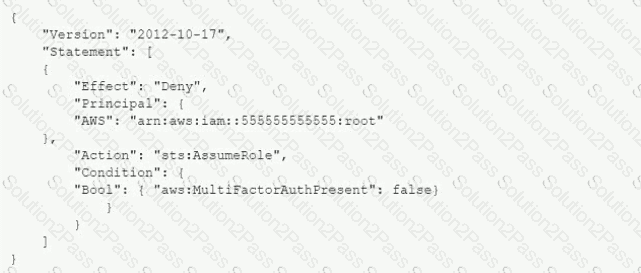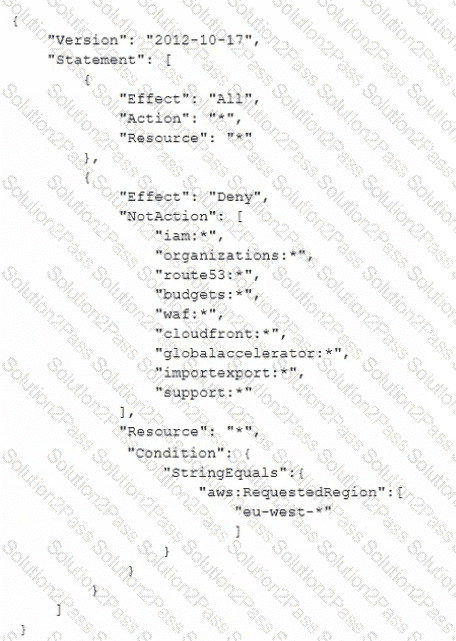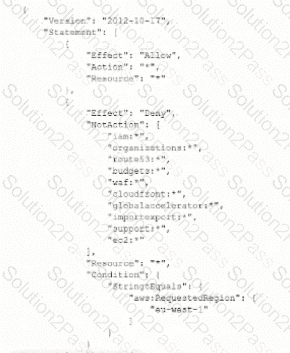SCS-C02 Amazon Web Services AWS Certified Security - Specialty Free Practice Exam Questions (2025 Updated)
Prepare effectively for your Amazon Web Services SCS-C02 AWS Certified Security - Specialty certification with our extensive collection of free, high-quality practice questions. Each question is designed to mirror the actual exam format and objectives, complete with comprehensive answers and detailed explanations. Our materials are regularly updated for 2025, ensuring you have the most current resources to build confidence and succeed on your first attempt.
A company needs to improve its ability to identify and prevent IAM policies that grant public access or cross-account access to resources. The company has implemented AWS Organizations and uses AWS IAM Access Analyzer. A security engineer must automate a response for newly created overly permissive policies to remediate access and notify the security team.
Select THREE:
A company has public certificates that are managed by AWS Certificate Manager (ACM). The certificates are either imported certificates or managed certificates from ACM with mixed validation methods. A security engineer needs to design a monitoring solution to provide alerts by email when a certificate is approaching its expiration date.
What is the MOST operationally efficient way to meet this requirement?
A company runs workloads on Amazon EC2 instances. The company needs to continually scan the EC2 instances for software vulnerabilities and unintended network exposure.
Which solution will meet these requirements?
A company has deployed AWS Control Tower and an organization in AWS Organizations to manage its AWS accounts. The company needs to implement the AWS Foundational Security Best Practices standard and must centrally log findings for the organization into one account.
Which solution will meet these requirements?
A security engineer is trying to use Amazon EC2 Image Builder to create an image of an EC2 instance. The security engineer has configured the pipeline to send logs to an Amazon S3 bucket. When the security engineer runs the pipeline, the build fails with the following error: “AccessDenied: Access Denied status code: 403”.
The security engineer must resolve the error by implementing a solution that complies with best practices for least privilege access.
Which combination of steps will meet these requirements? (Choose two.)
A startup company is using a single AWS account that has resources in a single AWS Region. A security engineer configures an AWS Cloud Trail trail in the same Region to deliver log files to an Amazon S3 bucket by using the AWS CLI.
Because of expansion, the company adds resources in multiple Regions. The secu-rity engineer notices that the logs from the new Regions are not reaching the S3 bucket.
What should the security engineer do to fix this issue with the LEAST amount of operational overhead?
A company is running an application in The eu-west-1 Region. The application uses an IAM Key Management Service (IAM KMS) CMK to encrypt sensitive data. The company plans to deploy the application in the eu-north-1 Region.
A security engineer needs to implement a key management solution for the application deployment in the new Region. The security engineer must minimize changes to the application code.
Which change should the security engineer make to the IAM KMS configuration to meet these requirements?
A company manages multiple AWS accounts using AWS Organizations. The company's security team notices that some member accounts are not sending AWS CloudTrail logs to a centralized Amazon S3 logging bucket. The security team wants to ensure there is at least one trail configured for all existing accounts and for any account that is created in the future.
Which set of actions should the security team implement to accomplish this?
A company's Security Auditor discovers that users are able to assume roles without using multi-factor authentication (MFA). An example of a current policy being applied to these users is as follows:

The Security Auditor finds that the users who are able to assume roles without MFA are alt coming from the IAM CLI. These users are using long-term IAM credentials. Which changes should a Security Engineer implement to resolve this security issue?(Select TWO.)
A)

B)

C)

D)

E)

A company has several workloads running on AWS. Employees are required to authenticate using on-premises ADFS and SSO to access the AWS Management
Console. Developers migrated an existing legacy web application to an Amazon EC2 instance. Employees need to access this application from anywhere on the internet, but currently, there is no authentication system built into the application.
How should the Security Engineer implement employee-only access to this system without changing the application?
A System Administrator is unable to start an Amazon EC2 instance in the eu-west-1 Region using an IAM role The same System Administrator is able to start an EC2 instance in the eu-west-2 and eu-west-3 Regions. The IAMSystemAdministrator access policy attached to the System Administrator IAM role allows unconditional access to all IAM services and resources within the account
Which configuration caused this issue?
A) An SCP is attached to the account with the following permission statement:

B)
A permission boundary policy is attached to the System Administrator role with the following permission statement:

C)
A permission boundary is attached to the System Administrator role with the following permission statement:

D)
An SCP is attached to the account with the following statement:

A company is running its application on AWS Malicious users exploited a recent promotion event and created many fake accounts
The application currently uses Amazon CloudFront in front of an Amazon API Gateway API. AWS Lambda functions serve the different API endpoints. The GET registration endpoint is behind the path of /store/registration. The URI for submission of the new account details is at /store/newaccount.
A security engineer needs to design a solution that prevents similar exploitations for future promotion events.
Which combination of steps will meet these requirements? {Select TWO.)
A company is using an Amazon CloudFront distribution to deliver content from two origins. One origin is a dynamic application that is hosted on Amazon EC2 instances. The other origin is an Amazon S3 bucket for static assets.
A security analysis shows that HTTPS responses from the application do not comply with a security requirement to provide an X-Frame-Options HTTP header to prevent frame-related cross-site scripting attacks. A security engineer must ipake the full stack compliant by adding the missing HTTP header to the responses.
Which solution will meet these requirements?
A company has an AWS Key Management Service (AWS KMS) customer managed key with imported key material Company policy requires all encryption keys to be rotated every year
What should a security engineer do to meet this requirement for this customer managed key?
A company has a requirement that none of its Amazon RDS resources can be publicly accessible. A security engineer needs to set up monitoring for this requirement and must receive a near-real-time notification if any RDS resource is noncompliant.
Which combination of steps should the security engineer take to meet these requirements? (Select THREE.)
An IAM user receives an Access Denied message when the user attempts to access objects in an Amazon S3 bucket. The user and the S3 bucket are in the same AWS account. The S3 bucket is configured to use server-side encryption with AWS KMS keys (SSE-KMS) to encrypt all of its objects at rest by using a customer managed key from the same AWS account. The S3 bucket has no bucket policy defined. The IAM user has been granted permissions through an IAM policy that allows the kms:Decrypt permission to the customer managed key. The IAM policy also allows the s3:List* and s3:Get* permissions for the S3 bucket and its objects.
Which of the following is a possible reason that the IAM user cannot access the objects in the S3 bucket?
A company runs a cron job on an Amazon EC2 instance on a predefined schedule The cron job calls a bash script that encrypts a 2 KB file. A security engineer creates an AWS Key Management Service (AWS KMS) customer managed key with a key policy. The key policy and the EC2 instance rote have the necessary configuration for this job.
Which process should the bash script use to encrypt the file?
A company has several Amazon S3 buckets thai do not enforce encryption in transit A security engineer must implement a solution that enforces encryption in transit for all the company's existing and future S3 buckets.
Which solution will meet these requirements'?
A company needs to detect unauthenticated access to its Amazon Elastic Kubernetes Service (Amazon EKS) clusters. The company needs a solution that requires no additional configuration of the existing EKS deployment.
Which solution will meet these requirements with the LEAST operational effort?
A company is using AWS Organizations with nested OUs to manage AWS accounts. The company has a custom compliance monitoring service for the accounts. The monitoring service runs as an AWS Lambda function and is invoked by Amazon EventBridge Scheduler.
The company needs to deploy the monitoring service in all existing and future accounts in the organization. The company must avoid using the organization's management account when the management account is not required.
Which solution will meet these requirements?
